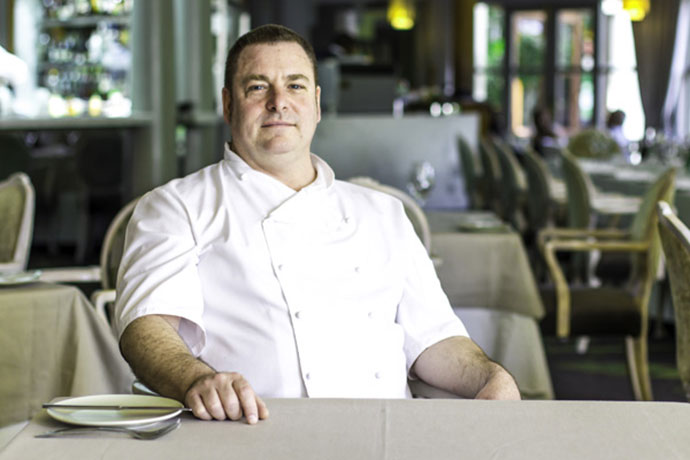With Ginja, his inner city Cape Town restaurant constantly full, Mike Bassett has branched out to the leafy suburbs to open his new restaurant, Myoga, at the Vineyard Hotel.
By Gill Cullinan
With Ginja, his inner city Cape Town restaurant constantly full, Mike Bassett has branched out to the leafy suburbs to open his new restaurant, Myoga, at the Vineyard Hotel Meeting Mike Bassett at his new restaurant Myoga is one thing, getting him to sit still and talk about this venture is another. The finishing touches are being done to the space before the restaurant launch and he can’t walk a metre without an electrician, a chef or the restaurant manager needing his attention. While he has a very clear vision of how Myoga will look, this putting-it-all-together stage is the part he hates. He’d like the restaurant to be ready so that he can get into the kitchen and continue testing recipes.
Mike blames his impatience on a desire for instant gratification – he just loves his new Bonnet stove (give him the choice between two Ferraris or this stove and he’d choose the stove) and wants to use it. It’s the kind of stove he cooked on while working at Raymond Blanc’s Le Manoir Aux Quat’ Saisons, and he’d always hoped for one of his own. Myoga’s setting in the Vineyard Hotel in Newlands, Lady Anne Barnard’s 18th-century retreat, reminds him of his time at Le Manoir Aux Quat’ Saisons. A five-star, familyowned hotel, the Vineyard has a lush, five-acre garden with spectacular views of Table Mountain, and diners lunching on the terrace can enjoy the full impact of the garden’s beauty.
Mike’s interest in food began as a child, when he started experimenting with leftovers and cooking jaffles at the age of six. “When other kids were happy with fish fingers I felt I was missing something; I needed to taste more,” says Mike. “I also discovered that by cooking I could give people pleasure.” Throughout his school days it was an interest that he largely kept to himself. “I probably would have studied home economics if I hadn’t been on the rugby team,” he says. Hotel School at Wits was followed by a stint cooking in hospital kitchens for cardiac patients and then a couple of months at the Spur franchise. After working at The Peninsula hotel, he was asked to run the boutique hotel Ellerman House for two years. “Do you know what a pleasure it was to spend an entire day working on a dish for just four people?” he says.
When Raymond Blanc and Marco Pierre White came to his attention he began dreaming of working for Raymond and travelled to the UK to work at Le Manoir Aux Quat’ Saisons. Since returning to South Africa he’s opened at Victoria Junction, worked at Villa Via, opened Yum, worked on the African Queen riverboat in Zambia and learnt how to consult under difficult circumstances in Nigeria.
He is also known to have chased a restaurant manager with a meat cleaver. “It was unintentional,” says Mike. “He upset me. Needless to say we are still friends.” We laugh about this, but it’s symbolic of Mike’s campaign to forge respect for chefs. “It’s not about the ego,” he says. “It’s about equalising things. I believe in training and motivating my staff.
I was notorious for throwing general managers out of the kitchen in front of the staff, but I made chefs take control. Without the interference of management, chefs do their jobs with far more passion.” Mike also played a large role in improving the quality of produce available to chefs. “I went to Australia, the Far East and New York and came back frustrated that we couldn’t get the same produce here. I started demanding better quality, and now at least we have perlemoen farms and better scallops and fish.”
Mike’s culinary style is global fusion. “Even some molecular gastronomy is fusion,” he says. “Something may be air but if it has the flavours of Thailand then it’s fusion. Apart from chefs who dedicate themselves to one style, most chefs who go beyond regional food, who use a touch of soy sauce or a bit of seaweed, will be doing fusion.” Mike opened Ginja in 2001 in Etienne Bonthuys’s restaurant space, an old Victorian building near Green Point. He plans to work between Ginja and Myoga. “I want to carry on what I’m doing at Ginja but do it better,” he says. “In terms of food we will be experimental for a while until Myoga has established its own identity. It will definitely be global fusion and we will use some of Ginja’s greatest hits.”
SOURCES
By Henrique Wilding

